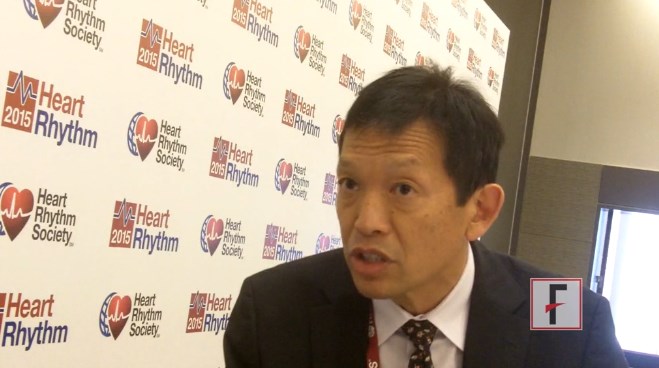User login
BOSTON – The prospect of soon having two new, different options for placing implantable cardioverter defibrillators (ICDs) that can safely undergo MRI exposure is “really important,” Dr. Fred M. Kusumoto said in an interview at the annual scientific sessions of the Heart Rhythm Society.
Researchers presented results from two independent, pivotal trials that showed the safety and efficacy of one of the new devices in patients who underwent MRI with 1.5 Tesla imagers.
Once the devices come onto the U.S. market they will likely be placed first in younger patients as well as older patients who seem likely to need MRI in the foreseeable future. As electrophysiologists grow more comfortable with the MRI-compatible ICDs, their use will gradually become more commonplace, Dr. Kusumoto predicted. That’s what happened when MRI-compatible pacemakers first became available, noted Dr. Kusumoto, professor of medicine and an electrophysiologist at the Mayo Clinic in Jacksonvile, Fla.
The next frontier for MRI-compatible implanted cardiac devices will be cardiac resynchronization therapy units, but with their more complicated design and lead placement that step will pose additional design and engineering challenges, he said.
Dr. Kusumoto had no relevant disclosures.
The video associated with this article is no longer available on this site. Please view all of our videos on the MDedge YouTube channel
On Twitter @mitchelzoler
This article was updated 5/18/2015.
BOSTON – The prospect of soon having two new, different options for placing implantable cardioverter defibrillators (ICDs) that can safely undergo MRI exposure is “really important,” Dr. Fred M. Kusumoto said in an interview at the annual scientific sessions of the Heart Rhythm Society.
Researchers presented results from two independent, pivotal trials that showed the safety and efficacy of one of the new devices in patients who underwent MRI with 1.5 Tesla imagers.
Once the devices come onto the U.S. market they will likely be placed first in younger patients as well as older patients who seem likely to need MRI in the foreseeable future. As electrophysiologists grow more comfortable with the MRI-compatible ICDs, their use will gradually become more commonplace, Dr. Kusumoto predicted. That’s what happened when MRI-compatible pacemakers first became available, noted Dr. Kusumoto, professor of medicine and an electrophysiologist at the Mayo Clinic in Jacksonvile, Fla.
The next frontier for MRI-compatible implanted cardiac devices will be cardiac resynchronization therapy units, but with their more complicated design and lead placement that step will pose additional design and engineering challenges, he said.
Dr. Kusumoto had no relevant disclosures.
The video associated with this article is no longer available on this site. Please view all of our videos on the MDedge YouTube channel
On Twitter @mitchelzoler
This article was updated 5/18/2015.
BOSTON – The prospect of soon having two new, different options for placing implantable cardioverter defibrillators (ICDs) that can safely undergo MRI exposure is “really important,” Dr. Fred M. Kusumoto said in an interview at the annual scientific sessions of the Heart Rhythm Society.
Researchers presented results from two independent, pivotal trials that showed the safety and efficacy of one of the new devices in patients who underwent MRI with 1.5 Tesla imagers.
Once the devices come onto the U.S. market they will likely be placed first in younger patients as well as older patients who seem likely to need MRI in the foreseeable future. As electrophysiologists grow more comfortable with the MRI-compatible ICDs, their use will gradually become more commonplace, Dr. Kusumoto predicted. That’s what happened when MRI-compatible pacemakers first became available, noted Dr. Kusumoto, professor of medicine and an electrophysiologist at the Mayo Clinic in Jacksonvile, Fla.
The next frontier for MRI-compatible implanted cardiac devices will be cardiac resynchronization therapy units, but with their more complicated design and lead placement that step will pose additional design and engineering challenges, he said.
Dr. Kusumoto had no relevant disclosures.
The video associated with this article is no longer available on this site. Please view all of our videos on the MDedge YouTube channel
On Twitter @mitchelzoler
This article was updated 5/18/2015.
AT HEART RHYTHM 2015
